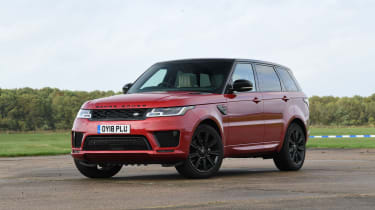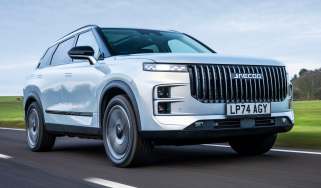Range Rover Sport SUV review (2013-2022)
"The Range Rover Sport isn’t cheap, but it offers most of its big brother’s luxury, while being more fun to drive"
Pros
- Good grip in corners
- Luxurious interior
- Comfortable ride
Cons
- Expensive to run
- Uncertain reliability
- Less boot space than the old model
The second-generation Range Rover Sport lives up to its name with a responsive feel. In today's broad Land Rover range, the Sport slots in above the Range Rover Evoque and eye-catching Range Rover Velar, but below the full-sized Range Rover. From behind the wheel it manages to have a distinct character, and there's less crossover of customers between the Sport and Range Rover than you may expect.
It’s certainly a big SUV and while it may not be quite as overtly sporting as models such as the Porsche Cayenne Coupe, BMW X6 and Mercedes GLE Coupe – the Range Rover majors more on cruising comfort than sporting prowess – it’s still a genuine competitor for these models, with impressive handling for its size. What's more, the Range Rover Sport lives up to its heritage with surprising off-road capability thanks to highly adjustable air suspension and a clever four-wheel-drive system called Terrain Response.
Since its launch, Land Rover has expanded the Sport’s engine range to appeal to a wider range of customers and its diesel line-up has proved very popular in the UK. Despite the Sport's advancing age, Land Rover saw fit to usher in a trio of new 3.0-litre straight-six diesel engines during 2020, badged D250, D300 and D350. These are not only powerful, but mild-hybrid tech also gives fuel economy a helping hand with all three engines returning around 30mpg.
More reviews
Car trim reviews
In-depth reviews
- Range Rover Sport review – comfortable and good to drive
- Range Rover Sport PHEV review
- Range Rover Sport PHEV SUV (2013-2022) review
Road tests
Used car reviews
For a truly economical drive, why not take a look at the Range Rover Sport P400e PHEV SUV
Business users, meanwhile, will be fans of the P400e plug-in hybrid, which combines a 2.0-litre petrol engine, battery and electric motor to produce the equivalent of 399bhp. That's enough for 0-62mph in just 6.3 seconds, while promising over 80mpg if you make a lot of short journeys around town that make the most of its electric range. CO2 emissions from around 75g/km mean a mid-range Benefit-in-Kind (BiK) rate company car tax.
For buyers who prefer a traditional petrol engine, there’s the 396bhp 3.0-litre P400 which features mild-hybrid electrical assistance. It offers a strong turn of pace, managing 0-62mph in 5.9 seconds and returns around 27mpg.
If you really want to maximise the Sport factor, then look to Jaguar Land Rover’s Special Vehicle Operations (SVO) division. This is the team responsible for building the Jaguar F-Type SVR, and the muscle-bound sports machine shares its mighty supercharged V8 with the Range Rover Sport SVR. It's a muscular 567bhp 5.0-litre engine that sprints from 0-62mph in a scant 4.5 seconds. All of this considerable performance naturally affects economy, though, with an official figure of around 19mpg possible with careful driving.
During the Range Rover Sport's last round of updates, its design was refreshed to bring it closer to the svelte Velar, both outside – with a slimmer front grille and matching headlights – and inside, where a cutting-edge two-tier infotainment system steals the show. Regardless of trim level, the interior feels well appointed with soft and luxurious materials, while the large boot also makes the Sport very practical. A third row of seats can be added, too, but the space offered is only suitable for children.
We review the 567bhp Range Rover Sport SVR
There are plenty of reasons for passengers to be happy, too, with spacious and comfortable seats front and rear. There’s also lots of standard and optional equipment, with even entry-level HSE cars getting heated front and back seats, 20-inch alloy wheels, front and rear parking sensors and cruise control, but the InControl Touch Pro infotainment system feels dated compared to Land Rover's latest Pivi Pro software in newer models like the Land Rover Defender. Progress through HSE Dynamic, Autobiography Dynamic and the high-performance SVR models and the list of equipment is even more impressive.
The Range Rover Sport itself hasn’t been crash-tested by Euro NCAP, but the full-size Range Rover received five stars in 2012, and while they’re quite different, the Land Rover Discovery Sport also achieved the same result when tested in 2014. This makes us confident the Sport would be similarly safe in an accident. Perhaps a bigger concern will be reliability, with Land Rover finishing 22nd out of 29 brands in our 2021 Driver Power owner satisfaction survey.
A brand-new Range Rover Sport is slated to arrive in late 2022, and will follow the new Range Rover into showrooms. The new model will feature styling cues from the Velar, and will be slightly larger with improved practicality. It’ll also adopt all of the brand’s latest technology, including a new infotainment system along with a choice of petrol, diesel and plug-in hybrid engines.
See how the PHEV model scored on our sister site DrivingElectric
















